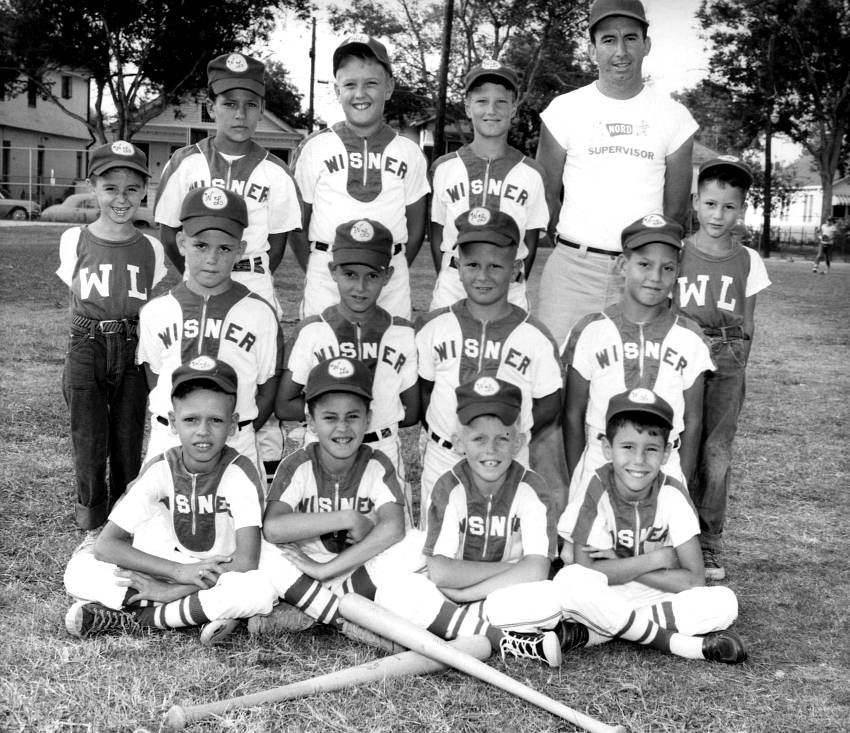Turn Back the Clock: Wisner Playground fostered a lifestyle in Uptown neighborhood – crescentcitysports.com
REPLAY: MLK Classic boys basketball — Newman-Zachary and Carver-Karr
There was a time spanning the 1950s through the 1970s when Wisner Playground was the center of activity in the surrounding New Orleans Uptown neighborhood. Men and women now in their 50s, 60s and 70s still vividly recall their teams, coaches, practices, and games that consumed their days at the playground during that era. They refer to the connection of their neighborhood with the playground as a “lifestyle” for the kids and parents who lived in the area.
According to the Times-Picayune, Wisner Playground came about in 1938, when the mayor of New Orleans was authorized to establish a playground in the square bounded by Upperline, Lyons, Annunciation and Laurel streets. The playground was named after the late Edward Wisner and funded by proceeds from the Wisner Foundation established upon his death in the early 1900s. Houses that occupied the area were purchased and razed to make room for the new playground.
The New Orleans Recreation Department (NORD) was founded in the late 1940s to organize the playgrounds and recreational facilities of the city in order to provide opportunities for youngsters from ages 8 to 18 to participate in sports, swimming and other recreational activities. NORD became the envy of other American cities for its progressive city-wide organization of facilities and leagues, particularly for youth baseball. Wisner Playground was one of many other city recreational facilities to ultimately fall under NORD’s direction, and it still remains that way today.
Larry Scott was the NORD playground supervisor assigned to Wisner from 1970 to 1980. He had participated in sports at the playground from six years old through junior high school. He recalls that it consisted of one backstop on a baseball diamond and a cement basketball court.
There wasn’t enough space for a full 100-yard football field, so practices took place on a shortened field. Scott recalled that the playground was practically used all day in the summer for practices by the various teams and league games scheduled there. He would spend all day coaching his teams and pitching batting practice for other teams.
“Wisner Playground was the hub of the neighborhood. It was like a second home to the kids.” said Scott, who credits Ronnie Aucoin, Rene Esquerre and Jerry Burrage with setting the standard for Wisner coaches. Scott believes the successes of Wisner were largely due to its dedicated coaches and a committed group of parents.
Esquerre was recruited by Aucoin, the first playground supervisor, as a summer coach in 1956 as a 15-year-old. He wound up remaining there as a coach and supervisor into the late 1960s.
Some years his baseball teams played up to 60 games a season, competing in multiple leagues and tournaments from April to August. Esquerre recalls what became known as the “August League” which was very popular at the playground, because it was a time at the end of summer when boys from all age groups would choose teams and play easy-pitch baseball.
Burrage had played sports at the playground as a youngster and wound up being hired as a coach by Esquerre. Burrage says, “I probably coached over a hundred kids in various sports during my 3-4 years at the playground. My time there was a contributing factor to my whole future in coaching that included various high schools in the New Orleans area.”
Johnny Arthurs, who played basketball and baseball for Tulane University and played in the NBA with the Milwaukee Bucks, says he started participating in the playground’s sports as an eight-year-old. He was on the Wisner 10-year-old and 12-year-old teams that won NORD city championships in 1957 and 1959. His coach for both teams was Aucoin, while his older brother Billy assisted with the 12-year-old team.
Arthurs recalls that he would leave his house early in the mornings and spend all day at the playground with the same group of boys, usually grabbing a po’boy for lunch at nearby Munster’s Bar and Grill. His parents told him he just had to be home by nightfall.
“The playground provided a comfort level for us and our parents, because we’d stay occupied there all day.” Arthurs said as he reflected on those days past. “Wisner was the steppingstone to my total sports career that included high school, college and professional levels.“
Wisner Playground had girls teams for softball, basketball, volleyball, and track. Ann Nunez says she played all the sports, starting at six years old, with Scott as her coach. She liked the fact that the teams had dedicated coaches who taught fundamentals of the sports.
“There was something to do every day at the playground, if you played all the sports. There was a wonderful, family-oriented environment. It was a great time in my life. I wish my son could have grown up and played sports in that environment,” noted Nunez.
One of Nunez’s teammates was Erin O’Connor, who also played all the sports. She prided herself in being able to strike out the boys in pickup games at the playground. She recalls that her teams won city championships in all the sports.
O’Connor, whose nickname was “Skinny,” says her athletic experience at Wisner Playground contributed to her attaining a volleyball scholarship at the University of New Orleans. Scott calls O’Connor one of the best female athletes to come out of the playground.
Alden Hagardorn was a baseball, basketball and football coach at Wisner Playground from 1970 to 1981. He was a product of St. Henry‘s and lived just a few blocks from the playground. He admits he wasn’t much of an athlete but instead gravitated toward coaching, after he started keeping score for teams with whom his father coached and his younger brother Jerry played.
When he was 20 years old, Hagardorn became an officer of the Wisner Playground Boosters Club primarily made up of parents of the kids. He eventually became president of the organization. He recalls the parents’ dedicated involvement in the club that arranged for full uniforms and equipment for all of the playground teams. The boosters held an annual awards banquet for the kids, providing trophies and jackets for championship teams.
During the football season, they sponsored a homecoming parade throughout the neighborhood, where the players rode on trucks, the homecoming court rode in convertibles, and the police department band marched with the kids. The football team had cheerleaders, and there was even a crowning of a homecoming queen chosen from the playground. Hagardorn says that homecoming was a neighborhood-wide event, with heavy involvement by the parents.
Hagardorn said, “The booster club supported all of the sports programs and events without ever having the kids pay for anything.” The boosters provided most of the funding, with assistance from businesses who helped with boys’ baseball uniforms.
Instead of having a concession stand on the playground to raise money, refreshments were bought at nearby Munster’s Bar and Grill, and the parents would often convene there after games. Hagardorn added, “We brought business to them, and in return they helped us raise money for the playground by holding bingos at their place. The owners of Munsters were very generous to Wisner. They were a part of the neighborhood experience.”
Gasper Mangerchine played on the same championship teams with Johnny Arthurs in the late 1950s. He points out that besides the sports that were an integral part of the playground, there was a covered shelter where kids could also play board games during the summer.
Currently, Mangerchine is one of the organizers of an annual Wisner Alumni Reunion. It brings together people, who have been part of the Wisner experience over the years, to reminisce about the playground’s heyday. Mangerchine says the reunions are usually held at Grits Bar on Lyons Street, and there have been years when as many as 250 people attended the event. O’Connor says she had put together a photo album for the Wisner Playground reunions years ago.
Bob Braniff remembers playing on 11-and-under NORD baseball teams at Wisner in the mid-1950s. His coaches were Aucoin and Esquerre. He recalls playing against a talented Allan Montreuil, who eventually played in the major leagues with the Chicago Cubs. Years later as an adult, Braniff came back to play at Wisner Playground with his company’s softball team in a city-wide men’s league that scheduled games there.
In addition to Arthurs, Wisner Playground produced other athletes who went on to play professional sports: Frank Wills with the Kansas City Royals, Cleveland Indians, Seattle Mariners, and Toronto Blue Jays; Marty Wetzel with the New York Jets; Dow Edwards with the New England Patriots; and Gerry Schoen with the Washington Senators. Joe Scheuermann, the highly successful athletic director and head baseball coach at Delgado Community College, is a former athlete from the playground.
The smaller, neighborhood playgrounds with extensive recreational programs like Wisner don’t exist anymore in the city. Wisner Playground remains under the NORD umbrella, but it doesn’t have programs for sports as it once had. According to Hagardorn, there is an eight-year-old and 10-year-old Little League program whose games are currently played at Wisner. The facility now features a dog run.
Playground coaches such as Aucoin, Esquerre, Burrage, Scott, and Hagardorn, along with the neighborhood’s parents, put their hearts and souls into Wisner Playground over the years. The kids were the beneficiaries of their efforts. It was a time and environment long-cherished by the athletes, parents and coaches.
Richard Cuicchi, Founder of the Metro New Orleans Area Baseball Player Database and a New Orleans area baseball historian, maintains TheTenthInning.com website. He also authored the book, Family Ties: A Comprehensive Collection of Facts and Trivia About Baseball’s Relatives. He has contributed to numerous SABR-sponsored Bio Project and Games Project books.
Read more >
Choose the most impressive 2021 football state champion:
View Results
2022 Crescent City Sports Enterprises LLC | All Rights Reserved | Advertise with CCSE
The material on this site may not be reproduced, distributed, transmitted, cached or otherwise used, except with the prior written permission of Crescent City Sports Enterprises.



